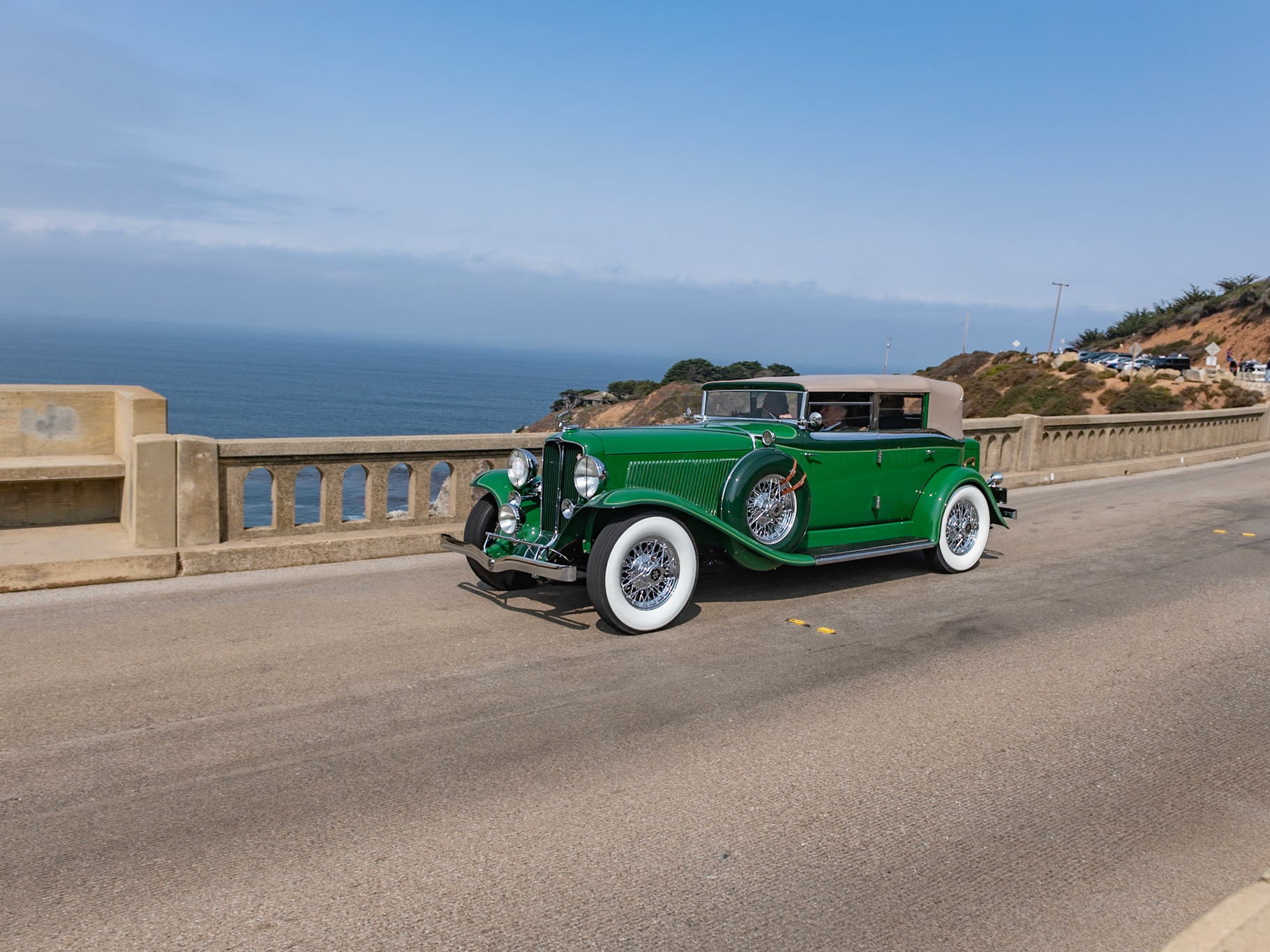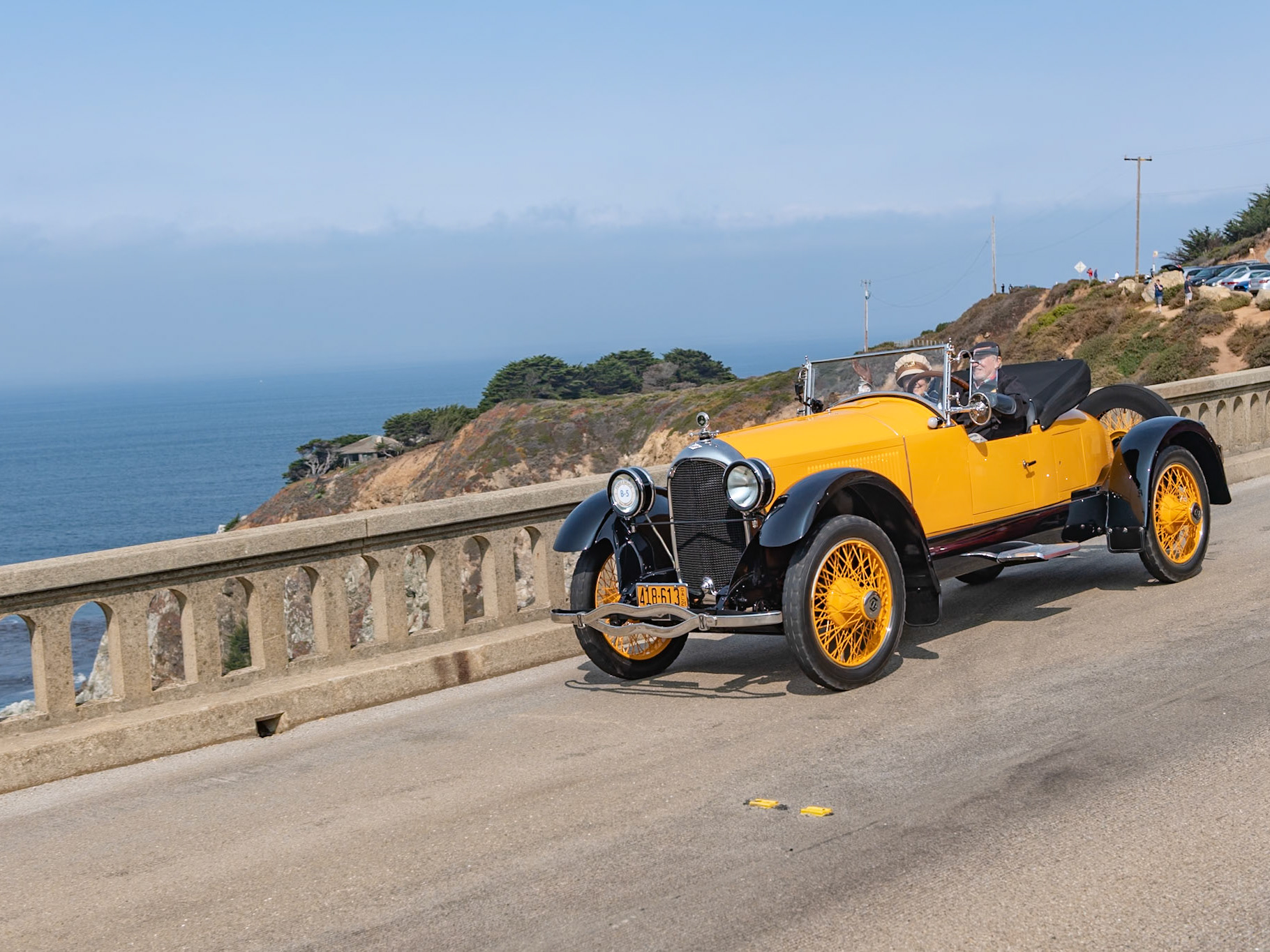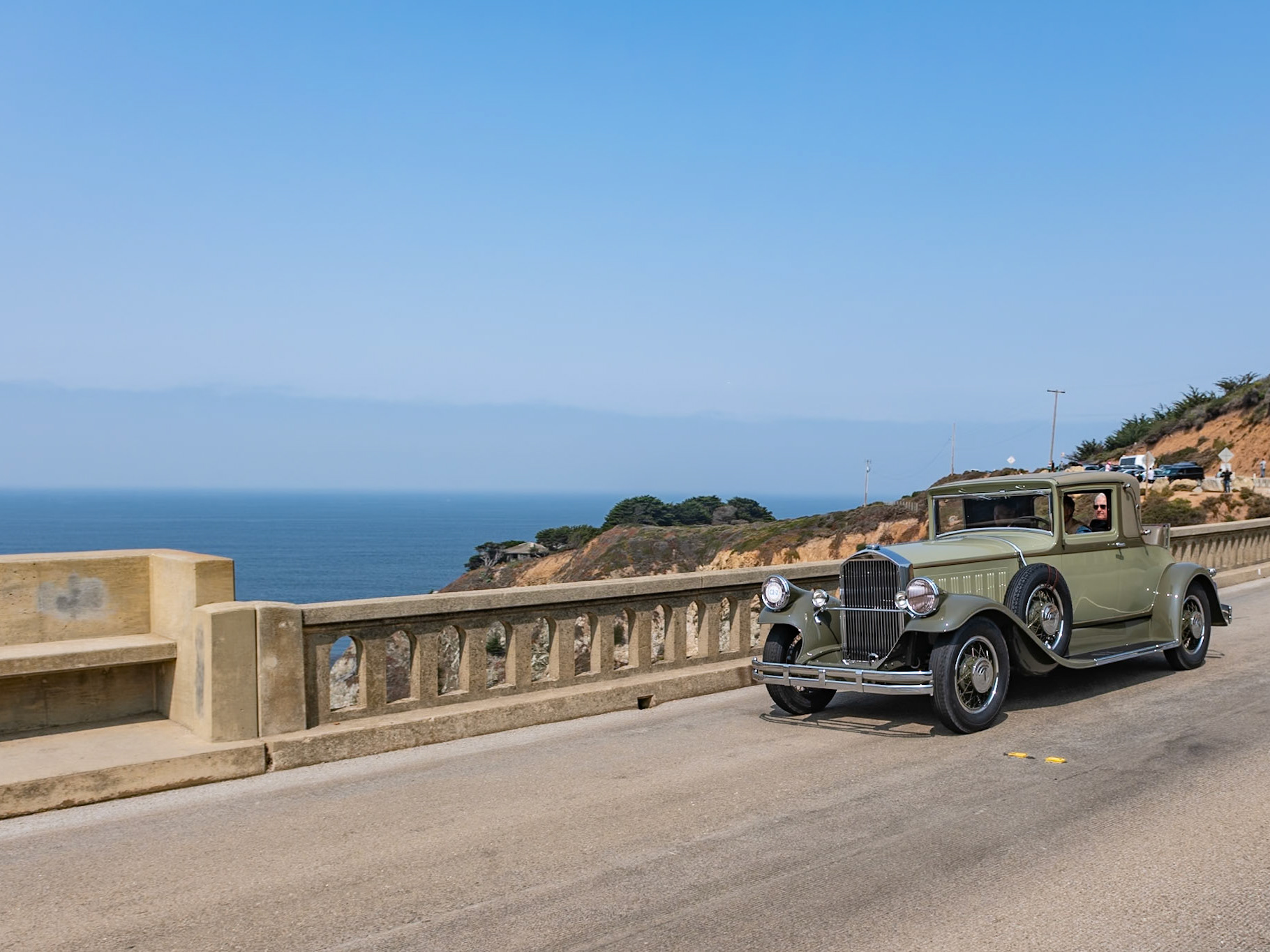
The Fiat 8V (the Otto Vu) made its public debut at the Geneva Auto Salon in March of 1952. The car was powered by Fiat’s new 70-degree, overhead-valve V8 engine designed by Dante Giacosa. A total of 114 examples of the 8V were built, and 40 of these had Fiat factory coachwork while the rest were finished by other Italian carrozzerie. Ghia built 15 of these 8V Supersonics designed by Giovanni Savonuzzi. This car is thought to have been the one shown at the 1954 New York Auto Show. The original owner of this car was Howard “Dutch” Darrin, who then sold it to Briggs Cunningham. It was one of two Supersonics bought by Darrin; he later sold the other one to actress Lana Turner. This car disappeared for a time, but in 1962 it was spotted in Beverly Hills without its original engine and transmission and painted red. Its current owner has restored the car, reuniting it with its original engine and returning it to its original paint color and trim.

The Fiat 8V (the Otto Vu) made its public debut at the Geneva Auto Salon in March of 1952. The car was powered by Fiat’s new 70-degree, overhead-valve V8 engine designed by Dante Giacosa. A total of 114 examples of the 8V were built, and 40 of these had Fiat factory coachwork while the rest were finished by other Italian carrozzerie. Ghia built 15 of these 8V Supersonics designed by Giovanni Savonuzzi. This car is thought to have been the one shown at the 1954 New York Auto Show. The original owner of this car was Howard “Dutch” Darrin, who then sold it to Briggs Cunningham. It was one of two Supersonics bought by Darrin; he later sold the other one to actress Lana Turner. This car disappeared for a time, but in 1962 it was spotted in Beverly Hills without its original engine and transmission and painted red. Its current owner has restored the car, reuniting it with its original engine and returning it to its original paint color and trim.

The first Fiat 508 C, introduced in 1937, was a small family saloon powered by a 1,089 cc 4-cylinder overhead-valve engine. Using that rather diminutive prewar chassis, this unique little Fiat 1100 C Barchetta was the first car designed and built by Pietro Frua for his Carrozzeria Frua. It had its world premiere at the 1947 Concorso di Como Coppa Villa d’Este and, after winning second in class, was described in glowing terms in contemporary press reports. For the next three years, the car passed among a series of owners in Turin, but in 1950 it was sold to a Mr. Monti in Pavia, a town south of Milan, who retained the one-off sports car for the next 33 years. Then, after several more Italian owners, its current custodian entered it in the Mille Miglia Storica in 2016, just prior to its restoration back to its original color. He returned with the car to the Concorso d’Eleganza Villa d’Este in 2017, 70 years after making its concours debut.

The first Fiat 508 C, introduced in 1937, was a small family saloon powered by a 1,089 cc 4-cylinder overhead-valve engine. Using that rather diminutive prewar chassis, this unique little Fiat 1100 C Barchetta was the first car designed and built by Pietro Frua for his Carrozzeria Frua. It had its world premiere at the 1947 Concorso di Como Coppa Villa d’Este and, after winning second in class, was described in glowing terms in contemporary press reports. For the next three years, the car passed among a series of owners in Turin, but in 1950 it was sold to a Mr. Monti in Pavia, a town south of Milan, who retained the one-off sports car for the next 33 years. Then, after several more Italian owners, its current custodian entered it in the Mille Miglia Storica in 2016, just prior to its restoration back to its original color. He returned with the car to the Concorso d’Eleganza Villa d’Este in 2017, 70 years after making its concours debut.

Fiat introduced its first all-new postwar passenger car, the Fiat 1400, in 1950, and it soon became the basis for many of the great Italian carrozzerie. This unique Fiat 1400 Cabriolet was designed by Giovanni Michelotti and bodied by Carrozzeria Vignale specifically for the 1952 Turin Motor Show, and it was later shown at the Concorso d’Eleganza dell’Automobile at the Villa Borghese in Rome. After seeing the car there, California resident Dorothea Herrsher purchased it from Vignale. She was very proud of her new toy, and in October 1952 she exhibited it at the Oakland Sports Car Show, where it was first in class. Its final public appearance was at a 1953 concours at the Ambassador Hotel in Los Angeles, where Herrsher was escorted by actor John Hart, who played The Lone Ranger. The Fiat was later driven by actor Kirk Douglas in the 1955 movie The Racers. The car was last registered in 1964 and was not seen for many years. Its current owner acquired the car in 2015, and it was returned to Italy for a complete restoration to ready it for Pebble Beach.

Fiat introduced its first all-new postwar passenger car, the Fiat 1400, in 1950, and it soon became the basis for many of the great Italian carrozzerie. This unique Fiat 1400 Cabriolet was designed by Giovanni Michelotti and bodied by Carrozzeria Vignale specifically for the 1952 Turin Motor Show, and it was later shown at the Concorso d’Eleganza dell’Automobile at the Villa Borghese in Rome. After seeing the car there, California resident Dorothea Herrsher purchased it from Vignale. She was very proud of her new toy, and in October 1952 she exhibited it at the Oakland Sports Car Show, where it was first in class. Its final public appearance was at a 1953 concours at the Ambassador Hotel in Los Angeles, where Herrsher was escorted by actor John Hart, who played The Lone Ranger. The Fiat was later driven by actor Kirk Douglas in the 1955 movie The Racers. The car was last registered in 1964 and was not seen for many years. Its current owner acquired the car in 2015, and it was returned to Italy for a complete restoration to ready it for Pebble Beach.

Fiat introduced its first all-new postwar passenger car, the Fiat 1400, in 1950, and it soon became the basis for many of the great Italian carrozzerie. This unique Fiat 1400 Cabriolet was designed by Giovanni Michelotti and bodied by Carrozzeria Vignale specifically for the 1952 Turin Motor Show, and it was later shown at the Concorso d’Eleganza dell’Automobile at the Villa Borghese in Rome. After seeing the car there, California resident Dorothea Herrsher purchased it from Vignale. She was very proud of her new toy, and in October 1952 she exhibited it at the Oakland Sports Car Show, where it was first in class. Its final public appearance was at a 1953 concours at the Ambassador Hotel in Los Angeles, where Herrsher was escorted by actor John Hart, who played The Lone Ranger. The Fiat was later driven by actor Kirk Douglas in the 1955 movie The Racers. The car was last registered in 1964 and was not seen for many years. Its current owner acquired the car in 2015, and it was returned to Italy for a complete restoration to ready it for Pebble Beach.

The first Fiat 508 C, introduced in 1937, was a small family saloon powered by a 1,089 cc 4-cylinder overhead-valve engine. Using that rather diminutive prewar chassis, this unique little Fiat 1100 C Barchetta was the first car designed and built by Pietro Frua for his Carrozzeria Frua. It had its world premiere at the 1947 Concorso di Como Coppa Villa d’Este and, after winning second in class, was described in glowing terms in contemporary press reports. For the next three years, the car passed among a series of owners in Turin, but in 1950 it was sold to a Mr. Monti in Pavia, a town south of Milan, who retained the one-off sports car for the next 33 years. Then, after several more Italian owners, its current custodian entered it in the Mille Miglia Storica in 2016, just prior to its restoration back to its original color. He returned with the car to the Concorso d’Eleganza Villa d’Este in 2017, 70 years after making its concours debut.

Fiat introduced its first all-new postwar passenger car, the Fiat 1400, in 1950, and it soon became the basis for many of the great Italian carrozzerie. This unique Fiat 1400 Cabriolet was designed by Giovanni Michelotti and bodied by Carrozzeria Vignale specifically for the 1952 Turin Motor Show, and it was later shown at the Concorso d’Eleganza dell’Automobile at the Villa Borghese in Rome. After seeing the car there, California resident Dorothea Herrsher purchased it from Vignale. She was very proud of her new toy, and in October 1952 she exhibited it at the Oakland Sports Car Show, where it was first in class. Its final public appearance was at a 1953 concours at the Ambassador Hotel in Los Angeles, where Herrsher was escorted by actor John Hart, who played The Lone Ranger. The Fiat was later driven by actor Kirk Douglas in the 1955 movie The Racers. The car was last registered in 1964 and was not seen for many years. Its current owner acquired the car in 2015, and it was returned to Italy for a complete restoration to ready it for Pebble Beach.

The Maharaja of Patiala ordered this Fiat after seeing a similar 1½-liter Fiat race at Monza in 1920. He requested artillery wheels, but the car arrived in India with wire wheels too weak for the local roads, so it was sent back to Turin for wheel replacement. The Maharaja was a keen supporter of the British Empire, contributing to the war effort during the Great War and being involved with many British charities. He was equally well known for his many accomplishments in India, including captaining the Indian cricket team in 1911. He was married 10 times and had 88 children, but was perhaps most famous for his passion for motor cars. He had 44 Rolls-Royces, all specially built for him. The Fiat 501S Corsa was among a few non–Rolls-Royce motor cars in his collection. Its subsequent history is not well known, but in the 1970s it was found in very bad condition with a tree growing through the cockpit. Its current owner has completely restored the car for its first visit to the United States.

The Maharaja of Patiala ordered this Fiat after seeing a similar 1½-liter Fiat race at Monza in 1920. He requested artillery wheels, but the car arrived in India with wire wheels too weak for the local roads, so it was sent back to Turin for wheel replacement. The Maharaja was a keen supporter of the British Empire, contributing to the war effort during the Great War and being involved with many British charities. He was equally well known for his many accomplishments in India, including captaining the Indian cricket team in 1911. He was married 10 times and had 88 children, but was perhaps most famous for his passion for motor cars. He had 44 Rolls-Royces, all specially built for him. The Fiat 501S Corsa was among a few non–Rolls-Royce motor cars in his collection. Its subsequent history is not well known, but in the 1970s it was found in very bad condition with a tree growing through the cockpit. Its current owner has completely restored the car for its first visit to the United States.

The Maharaja of Patiala ordered this Fiat after seeing a similar 1½-liter Fiat race at Monza in 1920. He requested artillery wheels, but the car arrived in India with wire wheels too weak for the local roads, so it was sent back to Turin for wheel replacement. The Maharaja was a keen supporter of the British Empire, contributing to the war effort during the Great War and being involved with many British charities. He was equally well known for his many accomplishments in India, including captaining the Indian cricket team in 1911. He was married 10 times and had 88 children, but was perhaps most famous for his passion for motor cars. He had 44 Rolls-Royces, all specially built for him. The Fiat 501S Corsa was among a few non–Rolls-Royce motor cars in his collection. Its subsequent history is not well known, but in the 1970s it was found in very bad condition with a tree growing through the cockpit. Its current owner has completely restored the car for its first visit to the United States.





















